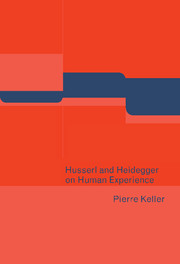Book contents
- Frontmatter
- Contents
- Introduction
- 1 Experience and intentionality
- 2 Husserl's methodologically solipsistic perspective
- 3 Husserl's theory of time-consciousness
- 4 Between Husserl, Kierkegaard, and Aristotle
- 5 Heidegger's critique of Husserl's methodological solipsism
- 6 Heidegger on the nature of significance
- 7 Temporality as the source of intelligibility
- 8 Heidegger's theory of time
- 9 Spatiality and human identity
- 10 “Dasein” and the forensic notion of a person
- Select bibliography
- Index
3 - Husserl's theory of time-consciousness
Published online by Cambridge University Press: 02 November 2009
- Frontmatter
- Contents
- Introduction
- 1 Experience and intentionality
- 2 Husserl's methodologically solipsistic perspective
- 3 Husserl's theory of time-consciousness
- 4 Between Husserl, Kierkegaard, and Aristotle
- 5 Heidegger's critique of Husserl's methodological solipsism
- 6 Heidegger on the nature of significance
- 7 Temporality as the source of intelligibility
- 8 Heidegger's theory of time
- 9 Spatiality and human identity
- 10 “Dasein” and the forensic notion of a person
- Select bibliography
- Index
Summary
Consciousness of time is the most fundamental level of all experience. For Husserl, this includes both human experience and the experience of any other actual creature. Thus, any searching analysis of the make-up of experience must begin with the structure of time-consciousness. In this chapter I look at Husserl's development of the structure of time-consciousness that is inherent in any experience, and point out the way in which he tries to resolve the tensions inherent in his conception of successively present episodes of experience.
THE TEMPORALITY OF EXPERIENCE AND THE PHENOMENOLOGICAL REDUCTION
Husserl's theory of time-consciousness emerges out of an effort to understand how acts of consciousness are themselves constituted as experiences (“Erlebnisse”). To make sense of acts of consciousness, he thinks that we must trace experiences back to their origins in the most immediate form of experience. Husserl assumes that the most immediate form of experience consists of sensations. Such sensations do not represent an object that is logically distinct from the having of a certain sensory experience. Sensations are, however, self-intimating. To be an impression involves an immediate consciousness of a qualitative experience. As experiences (“Erlebnisse”) they are conscious to the person who has them and as such involve a form of self-consciousness.
Sensations are not themselves the objects of perception, but they are experiencings that make a constitutive contribution to any perception. Unlike perceptions of objects, sensations do not seem to have intentionality. They represent objects, they are about objects, only in virtue of acts of consciousness in which the content of sensation is conceived of as or interpreted as belonging to objects.
- Type
- Chapter
- Information
- Husserl and Heidegger on Human Experience , pp. 59 - 83Publisher: Cambridge University PressPrint publication year: 1999

